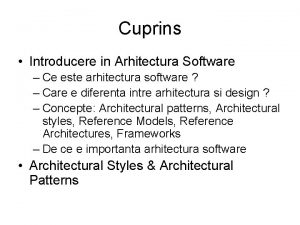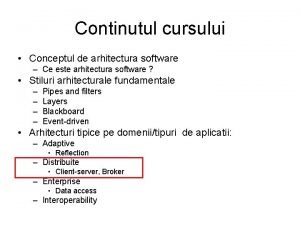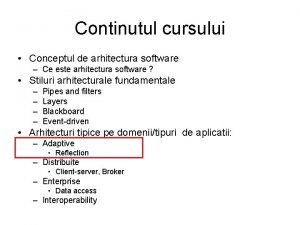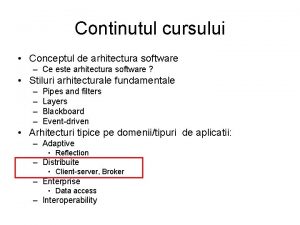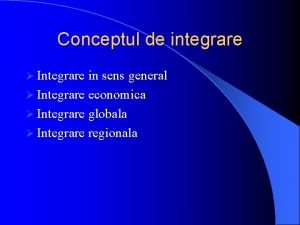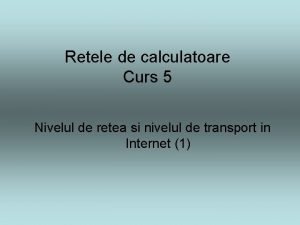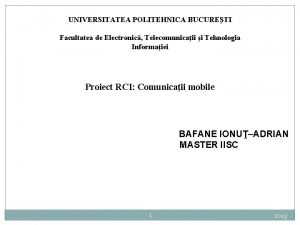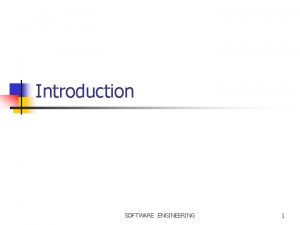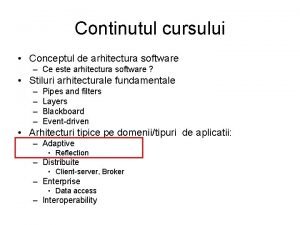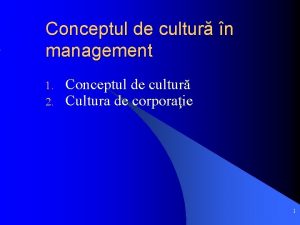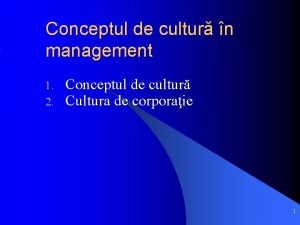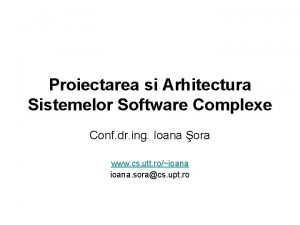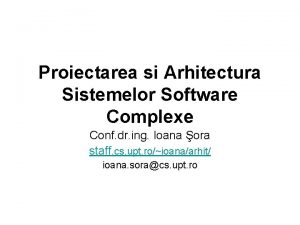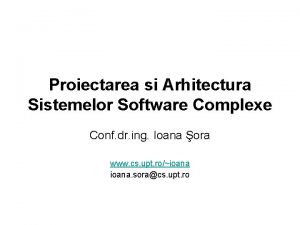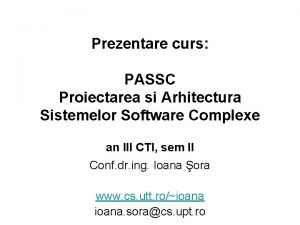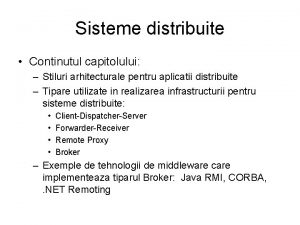Continutul cursului Conceptul de arhitectura software Ce este



















![Example: retrieving public constructors // get all public constructors Constructor[] ctors = c. get. Example: retrieving public constructors // get all public constructors Constructor[] ctors = c. get.](https://slidetodoc.com/presentation_image_h2/75019de1d95395681b4baa0f1dd43e06/image-20.jpg)
![Example: retrieving public methods //get all public methods Method[] ms = c. get. Methods(); Example: retrieving public methods //get all public methods Method[] ms = c. get. Methods();](https://slidetodoc.com/presentation_image_h2/75019de1d95395681b4baa0f1dd43e06/image-21.jpg)
![Example: retrieving declared methods //get all declared methods Method[] ms = c. get. Declared. Example: retrieving declared methods //get all declared methods Method[] ms = c. get. Declared.](https://slidetodoc.com/presentation_image_h2/75019de1d95395681b4baa0f1dd43e06/image-22.jpg)










![Example (C#) : Introspection Assembly a = Assembly. Load. File(args[0]); // Find Modules foreach Example (C#) : Introspection Assembly a = Assembly. Load. File(args[0]); // Find Modules foreach](https://slidetodoc.com/presentation_image_h2/75019de1d95395681b4baa0f1dd43e06/image-33.jpg)

- Slides: 34

Continutul cursului • Conceptul de arhitectura software – Ce este arhitectura software ? • Stiluri arhitecturale fundamentale – – Pipes and filters Layers Blackboard Event-driven • Arhitecturi tipice pe domenii/tipuri de aplicatii: – Adaptive • Reflection – Distribuite • Client-server, Broker – Enterprise • Data access – Interoperability

Reflection Bibliografie: Sun: The Java Tutorials – The Reflection API http: //download. oracle. com/javase/tutorial/reflect/index. html IBM developer. Works: Java programming dynamics, Part 2: Introducing reflection http: //www. ibm. com/developerworks/library/j-dyn 0603/ MSDN: Reflection http: //msdn. microsoft. com/en-us/library/f 7 ykdhsy. aspx

What is Reflection • Reflection: the process by which a program can observe and modify its own structure and behavior at runtime. • Based on RTTI (Run-Time Type Identification): – RTTI: allows programs to discover at runtime and use at runtime types that were not known at their compile time – Non-RTTI / Traditional approaches: • assume all types are known at compile time • Polymorphism in OO languages: is a particular case of very limited RTTI

Kinds of tasks specific to Reflection • Inspection: analyzing objects and types to gather information about their definition and behavior. – Find the run-time type information of an object – Find information about a type (supertypes, interfaces, members) • Dynamic type discovery • Manipulation: uses the information gained through inspection to change the structure/behavior: – create new instances of new types discovered at runtime – dynamically invoke discovered methods • Late binding: the types and methods used by a program are not known at compile-time – The most one could imagine to do in a reflective language: restructure types and objects on the fly !

How is Reflection implemented • Reflective capabilities need special support in language and compiler ! – Java: java. lang. reflection –. NET: System. Reflection

Reflection case study: Reflection in Java • java. lang. reflection • Class java. lang. reflect. Class – It is the entry point for all of the Reflection API – For each new class in a program a “Class” object is created. – Provides methods to examine the runtime properties of the object including its members and type information. – Provides the ability to create new objects of this type.

The Reflection Logical Hierarchy in Java Object compiled class file Class Field Method Constructor Member

Retrieving a Class object • Object. get. Class(): If an instance of an object is available, then the simplest way to get its Class is to invoke Object. get. Class(). Class c = "foo". get. Class(); • . class: If the type is available but there is no instance then it is possible to obtain a Class by appending ". class" to the name of the type. This is also the easiest way to obtain the Class for a primitive type. boolean b; Class c = b. get. Class(); // compile-time error Class c = boolean. class; // correct • Class. for. Name(): If the fully-qualified name of a class is available, it is possible to get the corresponding Class using the static method Class. for. Name() Class c. String = Class. for. Name("java. lang. String; ");

Inspecting a Class • After we obtain a Class object my. Class, we can: • Get the class name String s = my. Class. get. Name() ; • Get the class modifiers int m = my. Class. get. Modifiers() ; bool is. Public = Modifier. is. Public(m) ; bool is. Abstract = Modifier. is. Abstract(m) ; bool is. Final = Modifier. is. Final(m) ; • Test if it is an interface bool is. Interface = my. Class. is. Interface() ; • Get the interfaces implemented by a class Class [] itfs = my. Class. get. Interfaces() ; • Get the superclass Class super = my. Class. get. Super. Class() ;

Discovering Class members • fields, methods, and constructors • java. lang. reflect. * : – Member interface – Field class – Method class – Constructor class

Class Methods for Locating Members Member Field Method Constructor List of members? Inherited members ? Private members ? get. Declared. Field() no no yes get. Field() no yes no get. Declared. Fields() yes no yes get. Fields() yes no get. Declared. Method() no no yes get. Method() no yes no get. Declared. Methods() yes no yes get. Methods() yes no get. Declared. Constructor() no N/A 1 yes get. Constructor() no N/A 1 no get. Declared. Constructors() yes N/A 1 yes get. Constructors() yes N/A 1 no Class API

Class Methods for locating Fields • • get. Declared. Field(String name): Returns a Field object that reflects the specified declared field of the class or interface represented by this Class object. The name parameter is a String that specifies the simple name of the desired field. get. Field(String name): Returns a Field object that reflects the specified public member field of the class or interface represented by this Class object. The name parameter is a String specifying the simple name of the desired field. The field to be reflected is either declared in this class or in a superinterface or superclass. get. Declared. Fields(): Returns an array of Field objects reflecting all the fields declared by the class or interface represented by this Class object. This includes public, protected, default (package) access, and private fields, but excludes inherited fields. The elements in the array returned are not sorted and are not in any particular order get. Fields(): Returns an array containing Field objects reflecting all the accessible public fields of the class or interface represented by this Class object. Specifically, if this Class object represents a class, this method returns the public fields of this class and of all its superclasses. If this Class object represents an interface, this method returns the fields of this interface and of all its superinterfaces.

Class Methods for locating Methods • get. Declared. Method(String name): Returns a Method object to the specified method, declared in this class • get. Method(String name): Returns a Method object corresponding to the public specified method • get. Declared. Methods(): Returns an array of Method objects reflecting all (public and private) the methods declared by the class or interface represented by this Class object. • get. Methods(): Returns an array containing Method objects reflecting all the accessible public methods of the class or interface represented by this Class object.

Class Methods for locating Constructors • • get. Declared. Constructor (Class<? >. . . parameter. Types ): Returns a Constructor object that reflects the specified constructor of the class or interface represented by this Class object. The parameter. Types parameter is an array of Class objects that identify the constructor's formal parameter types, in declared order. ge. Constructor(Class<? >. . . parameter. Types): Returns a Constructor object that reflects the specified public constructor of the class represented by this Class object. The parameter. Types parameter is an array of Class objects that identify the constructor's formal parameter types, in declared order. get. Declared. Constructors(): Returns an array of Constructor objects reflecting all the constructors declared by the class represented by this Class object. These are public, protected, default (package) access, and private constructors. The elements in the array returned are not sorted and are not in any particular order. get. Constructors(): Returns an array containing Constructor objects reflecting all the accessible public constructors

Working with Class members • • • Members: fields, methods, and constructors For each member, the reflection API provides support to retrieve declaration and type information, and operations unique to the member (for example, setting the value of a field or invoking a method), java. lang. reflect. * : – “Member” interface – “Field” class: Fields have a type and a value. The java. lang. reflect. Field class provides methods for accessing type information and setting and getting values of a field on a given object. – “Method” class: Methods have return values, parameters and may throw exceptions. The java. lang. reflect. Method class provides methods for accessing type information for return type and parameters and invoking the method on a given object. – “Constructor” class: The Reflection APIs for constructors are defined in java. lang. reflect. Constructor and are similar to those for methods, with two major exceptions: first, constructors have no return values; second, the invocation of a constructor creates a new instance of an object for a given class.

Example: retrieving public fields Class c = Class. for. Name(“Dtest"); // get all public fields Field[] public. Fields = c. get. Fields(); for (int i = 0; i < public. Fields. length; ++i) { String field. Name = public. Fields[i]. get. Name(); Class type. Class = public. Fields[i]. get. Type(); System. out. println("Field: " + field. Name + " of type " + type. Class. get. Name()); }

Example public class Btest { public String a. Public. String; private String a. Private. String; public Btest(String a. String) { // … } public Btest(String s 1, String s 2) { // … } private void Op 1(String s) { // … } protected String Op 2(int x) { // … } public void Op 3() { // … } } public class Dtest extends Btest { public int a. Public. Int; private int a. Private. Int; public Dtest(int x) { // … } private void Op. D 1(String s) { // … } public String Op. D 2(int x){ // … } }

Example: retrieving public fields Class c = Class. for. Name(“Dtest"); // get all public fields Field[] public. Fields = c. get. Fields(); for (int i = 0; i < public. Fields. length; ++i) { String field. Name = public. Fields[i]. get. Name(); Class type. Class = public. Fields[i]. get. Type(); System. out. println("Field: " + field. Name + " of type " + type. Class. get. Name()); } Field: a. Public. Int of type int Field: a. Public. String of type java. lang. String

Example: retrieving declared fields Class c = Class. for. Name(“Dtest"); // get all declared fields Field[] public. Fields = c. get. Declared. Fields(); for (int i = 0; i < public. Fields. length; ++i) { String field. Name = public. Fields[i]. get. Name(); Class type. Class = public. Fields[i]. get. Type(); System. out. println("Field: " + field. Name + " of type " + type. Class. get. Name()); } Field: a. Public. Int of type int Field: a. Private. Int of type int
![Example retrieving public constructors get all public constructors Constructor ctors c get Example: retrieving public constructors // get all public constructors Constructor[] ctors = c. get.](https://slidetodoc.com/presentation_image_h2/75019de1d95395681b4baa0f1dd43e06/image-20.jpg)
Example: retrieving public constructors // get all public constructors Constructor[] ctors = c. get. Constructors(); for (int i = 0; i < ctors. length; ++i) { System. out. print("Constructor ("); Class[] params = ctors[i]. get. Parameter. Types(); for (int k = 0; k < params. length; ++k) { String param. Type = params[k]. get. Name(); System. out. print(param. Type + " "); } System. out. println(")"); } Constructor (int )
![Example retrieving public methods get all public methods Method ms c get Methods Example: retrieving public methods //get all public methods Method[] ms = c. get. Methods();](https://slidetodoc.com/presentation_image_h2/75019de1d95395681b4baa0f1dd43e06/image-21.jpg)
Example: retrieving public methods //get all public methods Method[] ms = c. get. Methods(); for (int i = 0; i < ms. length; ++i) { String mname = ms[i]. get. Name(); Class ret. Type = ms[i]. get. Return. Type(); System. out. print("Method : " + mname + " returns " + ret. Type. get. Name() + " parameters : Method ( "); : Op. D 2 returns java. lang. String parameters : ( int ) Class[] params = ms[i]. get. Parameter. Types(); Method : Op 3 returns void parameters : ( ) for (int k = 0; Method k < params. length; ++k) : wait returns void parameters : ( ) { Method : wait returns void parameters : ( long int ) String param. Type = params[k]. get. Name(); Method : wait returns void parameters : ( long ) System. out. print(param. Type + " "); int parameters : ( ) Method : hash. Code returns } Method : get. Class returns java. lang. Class parameters : ( ) System. out. println(") Method "); : equals returns boolean parameters : ( java. lang. Object ) } Method : to. String returns java. lang. String parameters : ( ) Method : notify returns void parameters : ( ) Method : notify. All returns void parameters : ( )
![Example retrieving declared methods get all declared methods Method ms c get Declared Example: retrieving declared methods //get all declared methods Method[] ms = c. get. Declared.](https://slidetodoc.com/presentation_image_h2/75019de1d95395681b4baa0f1dd43e06/image-22.jpg)
Example: retrieving declared methods //get all declared methods Method[] ms = c. get. Declared. Methods(); for (int i = 0; i < ms. length; ++i) { String mname = ms[i]. get. Name(); Class ret. Type = ms[i]. get. Return. Type(); System. out. print("Method : " + mname + " returns " + ret. Type. get. Name() + " parameters : ( "); Class[] params = ms[i]. get. Parameter. Types(); for (int k = 0; k < params. length; ++k) { String param. Type = params[k]. get. Name(); System. out. print(param. Type + " "); } System. out. println(") "); } Method : Op. D 1 returns void parameters : ( java. lang. String ) Method : Op. D 2 returns java. lang. String parameters : ( int )

Using Reflection for Program Manipulation • Previous examples used Reflection for Introspection only • Reflection is a powerful tool to: – Creating new objects of a type that was not known at compile time – Accessing members (accessing fields or invoking methods) that are not known at compile time

Using Reflection for Program Manipulation Object Class get/set compiled class file My. New. Class. class invoke Field Method Constructor

Creating new objects • Using Default Constructors – java. lang. reflect. Class. new. Instance() Class c = Class. for. Name(“java. awt. Rectangle”) ; Rectangle r = (Rectangle) c. new. Instance() ; • Using Constructors with Arguments – java. lang. reflect. Constructor. new. Instance(Object. . . initargs) Class c = Class. for. Name(“java. awt. Rectangle”) ; Class[] int. Args. Class = new Class[]{ int. class, int. class } ; Object[] int. Args = new Object[]{new Integer(12), new Integer(24)} ; Constructor = c. get. Constructor(int. Args. Class) ; Rectangle r = (Rectangle) ctor. new. Instance(int. Args) ;

Accessing fields • Getting Field Values Rectangle Class c = Field f = Integer h r = new Rectangle(12, 24) ; r. get. Class() ; c. get. Field(“height”) ; = (Integer) f. get(r) ; • Setting Field Values Rectangle r = new Rectangle(12, 24) ; Class c = r. get. Class() ; Field f = c. get. Field(“width”) ; f. set(r, new Integer(30)) ; // equivalent with: r. width=30

Invoking methods String s 1 = “Hello ” ; String s 2 = “World” ; Class c = String. class ; Class[] paramtypes = new Class[] { String. class } ; Object[] args = new Object[] { s 2 } ; Method concat. Method = c. get. Method(“concat”, paramtypes) ; String result = (String) concat. Method. invoke(s 1, args) ; // equivalent with result=s 1. concat(s 2);

Accessible Objects • Can request that Field, Method, and Constructor objects be “accessible. ” – Request granted if no security manager, or if the existing security manager allows it • Can invoke method or access field, even if inaccessible via privacy rules ! • Accesible. Object Class: the Superclass of Field, Method, and Constructor • boolean is. Accessible( ) – Gets the value of the accessible flag for this object • static void set. Accessible( Accessible. Object[] array, boolean flag ) – Sets the accessible flag for an array of objects with a single security check • void set. Accessible( boolean flag ) – Sets the accessible flag for this object to the indicated boolean value

Uses of Reflection • Extensibility Features : – An application may make use of external, user-defined classes by creating instances of extensibility objects using their fully-qualified names. • Class libraries that need to understand a type’s definition – Typical example = Serialization • Class Browsers and Visual Development Environments – A class browser needs to be able to enumerate the members of classes. Visual development environments can benefit from making use of type information available in reflection to aid the developer in writing correct code. • Debuggers and Test Tools – Debuggers need to be able to examine private members on classes. Test harnesses can make use of reflection to systematically call a discoverable set APIs defined on a class, to insure a high level of code coverage in a test suite.

Drawbacks of Reflection • If it is possible to perform an operation without using reflection, then it is preferable to avoid using it, because Reflection brings: • Performance Overhead – Because reflection involves types that are dynamically resolved, certain Java virtual machine optimizations can not be performed. Consequently, reflective operations have slower performance than their non-reflective counterparts • Security Restrictions – Reflection requires a runtime permission which may not be present when running under a security manager. • Exposure of Internals – Since reflection allows code to perform operations that would be illegal in non-reflective code, such as accessing private fields and methods, the use of reflection can result in unexpected side-effects, which may render code dysfunctional and may destroy portability. Reflective code breaks abstractions and therefore may change behavior with upgrades of the platform.

Reflection case study: Reflection in. NET • System. Reflection • What can you do with the System. Reflection API: – Enumerate modules and types of an assembly; – For each type, obtain its base type, implemented interfaces, fields, methods, properties, events – Create instances of types, dynamically invoke methods

The Reflection Logical Hierarchy in. NET Assembly Module Type MSIL code (exe, dll) Object Member. Info Field. Info Property. Info Event. Info Method. Base Method. Info Constructor. Info Member
![Example C Introspection Assembly a Assembly Load Fileargs0 Find Modules foreach Example (C#) : Introspection Assembly a = Assembly. Load. File(args[0]); // Find Modules foreach](https://slidetodoc.com/presentation_image_h2/75019de1d95395681b4baa0f1dd43e06/image-33.jpg)
Example (C#) : Introspection Assembly a = Assembly. Load. File(args[0]); // Find Modules foreach (Module m in assem. Get. Modules()) { Write. Line(1, "Module: {0}", m); // Find Types foreach (Type t in m. Get. Types()) { Write. Line(2, "Type: {0}", t); // Find Members foreach (Member. Info mi in t. Get. Members()) Write. Line(3, "{0}: {1}", mi. Member. Type, mi); } }

Conclusions • Reflective capabilities need special support at the levels of language (APIs) and compiler • Language (API) level: – Java: java. lang. reflection –. NET: System. Reflection – Very similar hierarchy of classes supporting reflection (Metaclasses) • Compiler level: – Speciffic type informations are saved together with the generated code (needed for type discovery and introspection) – The generated code must contain also code for automatically creating instances of the Metaclasses every time a new type is defined in the application code
 Arhitectura software
Arhitectura software Arhitectura software
Arhitectura software Arhitectura software
Arhitectura software Arhitectura software
Arhitectura software Arhitectura software
Arhitectura software Tipuri de invatare scolara
Tipuri de invatare scolara Conceptul de integrare
Conceptul de integrare Modelul biopsihosocial
Modelul biopsihosocial Principiile managementului public
Principiile managementului public Teoria curriculumului
Teoria curriculumului Conceptul de cultura
Conceptul de cultura Clasificarea metodelor didactice
Clasificarea metodelor didactice Referat istoria internetului
Referat istoria internetului Stil romanic si gotic
Stil romanic si gotic Structura sistemelor de calcul
Structura sistemelor de calcul Arhitectura retelelor de calculatoare
Arhitectura retelelor de calculatoare Componentele unui calculator
Componentele unui calculator Arhitectura greciei antice
Arhitectura greciei antice Cultura orientului antic
Cultura orientului antic Programe de arhitectura
Programe de arhitectura Arhitectura gsm
Arhitectura gsm Starh arhitectura
Starh arhitectura Arhitectura unui sistem de calcul
Arhitectura unui sistem de calcul Fiecare este robul lucrului de care este biruit
Fiecare este robul lucrului de care este biruit Gif compuserve
Gif compuserve Software este
Software este Software maintenance process models ppt
Software maintenance process models ppt What is software implementation in software engineering
What is software implementation in software engineering Improving software economics set 1
Improving software economics set 1 Computer science vs software engineering
Computer science vs software engineering Metrics computer science
Metrics computer science Computer skills for preparatory programs
Computer skills for preparatory programs Generic product in software engineering
Generic product in software engineering Difference between student software and industrial software
Difference between student software and industrial software Example of software crisis
Example of software crisis
